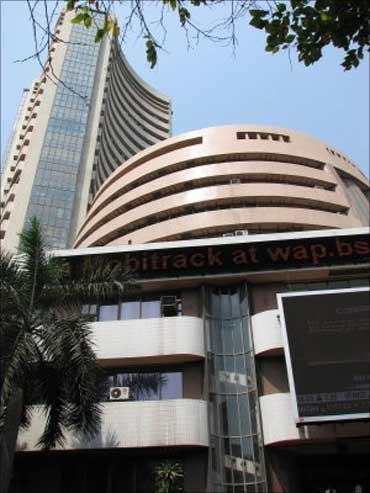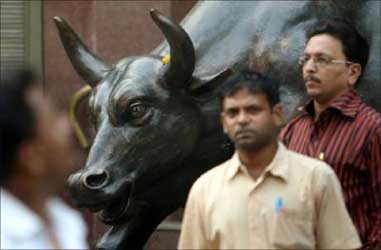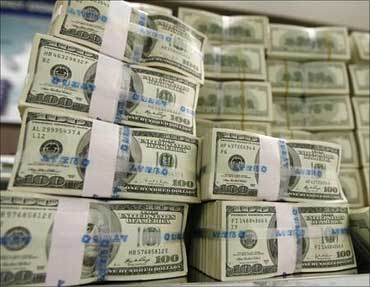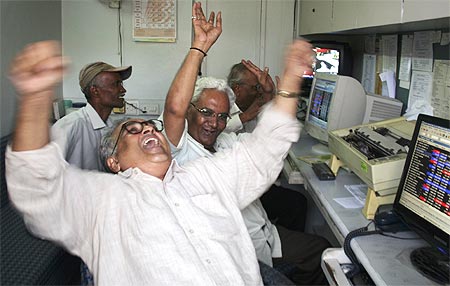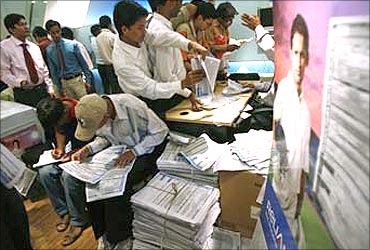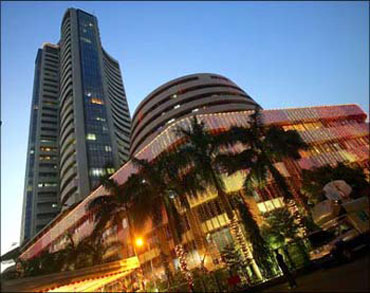 | « Back to article | Print this article |
Why next few days are vital for the stock market
As on December 31, 2010, the stock market indices Sensex and Nifty were at 20,561 and 6,134.5, respectively.
Since then the indices have witnessed a downward movement and the Sensex and Nifty stand at 17,900 and 5,300 levels, respectively, as on February 24.
As the stock market is considered to be the barometer of the impact of the Union Budget, what's your bet for the post-budget days? Read on to know more about it. . .
Going by the trends in the past, the stock market has always been highly volatile during the budget season. This is primarily due to the fact that there are high positive/negative expectations prior to the Budget.
Click NEXT to read on . . .
Why the next few days are vital for the stock market
As past is rarely a true indicator of the future, how do you really expect the market to behave post-Union Budget?
To understand where the markets are likely to move in the ensuing days, let's look at the past performance and the expectations of various stakeholders, viz, bankers, investors, corporates from the Budget.
Indian equity market performance in 2010
If you had invested in stocks belonging to sectors like consumer durables, FMCG, healthcare, banking, auto and IT last year then you would have easily earned healthy returns.
This can be primarily attributed to the rise in consumer demand, rise in purchasing power driven by higher disposable income, government initiatives like tax cuts, higher rural spending, etc.
Click NEXT to read on . . .
Why the next few days are vital for the stock market
However burgeoning current account deficit (which is more than 3 per cent of the GDP currently) and rising inflation have dampened the bullish move of the market and consequently the stock prices have nosedived.
Apart from that a string of scams and stock rigging issues have jolted the confidence of the investors. This resulted in individuals and institutions resorting to profit booking which brought down the stock prices of many mid caps and small caps.
Expectations from the Union Budget
Inflationary pressures: Inflation can be of two types -- demand-driven inflation and supply-driven inflation.
The demand side inflation is tackled by the Reserve Bank of India and the supply side has to be taken care by the government.
Click NEXT to read on . . .
Why the next few days are vital for the stock market
Going by the current trends on inflation, there is a belief that the inflation is primarily caused by the supply side constraints and hence the government should take up the responsibility to build infrastructure to mitigate the resource constraints.
Therefore, going forward, inflation will not only be determined by tweaking the repo rate and reverse repo rate but also be influenced by the government's budgetary allocation to build up the infrastructure.
Therefore, if the government starts spending on resources, you will witness an upsurge in the stock market.
Industrial output: The Index of Industrial Production (IIP) is the barometer of the output of various sectors like manufacturing, agriculture, services, etc.
Click NEXT to read on . . .
Why the next few days are vital for the stock market
As per the current figure, the industrial output in December 2010 grew at the slowest pace rising by a modest 1.6 per cent.
IIP has a huge impact on the stock market and hence moving ahead it is important to maintain a healthy IIP number. It is therefore hoped that the government should develop policies to encourage the capital intensive sector in India.
Top bankers have pondered over the need of creating big banks that can finance the capital intensive business. Hence, the government needs to work with RBI to have more clarity on norms to issue banking license in this year's Budget.
Foreign Direct Investment: With huge money stashed away in Swiss accounts as black money, the market being hit by a string of scams, runaway inflation rate and increasing fiscal deficit; the country has witnessed a huge outflow of foreign money.
Click NEXT to read on . . .
Why the next few days are vital for the stock market
Hence, the government is expected to come out with stringent measures to bring back black money which has been illegally kept away in foreign havens.
This would ease out the fiscal deficit pressures on the Indian economy and will eventually increase the FDI. Global retail giants Wal-Mart and Tesco are among the many big guns looking forward to tap the Indian market.
Hence, if the government takes serious note of the above mentioned aspects, it will go a long way in escalating the confidence of investors.
Infrastructure investment: In the next 5-7 years, it is envisaged that India will see a huge surge in capacity expansion in many sectors.
Click NEXT to read on . . .
Why the next few days are vital for the stock market
The infrastructure spending on 11th plan will be close to $500-billion mark which is going to be doubled (i.e. $1 trillion) in the next Five-Year Plan according to Planning Commission Deputy Chairman Montek Singh Ahluwalia.
The government is expecting private sector participation to the tune of 40%-50% in the $1 trillion infrastructure outlay during the 12th Plan period.
That offers immense scope to private companies looking to leverage the India growth story to fortify their business models. If there is adequate allocation of funds for infrastructure development, then the stock market will see a huge upsurge.
Click NEXT to read on . . .
Why the next few days are vital for the stock market
Outlook for 2011
If inflation continues to move up and consequently RBI hikes the interest rates by yet another 50-75 bps (0.5 to 0.75 per cent) then it might be a dampener for the market going forward in 2011.
Oil prices hike can also act as an impediment to the earnings growth in 2011. However, if the Budget proposals are favourable, there are a few sectors in which you might want to invest.
The Indian IT sector is expected to do well as the technology spend is going to move up. On the hope that the stock market will not witness any further scams and stock rigging issues, it might be a good time to relook a few mid-cap stocks.
But you need to be selective enough to pick those. Capital intensive sectors, like automobile, steel, cement and other infrastructure-related areas, might also do well if the government allocates sufficient funds in the Budget.
Power and road sector are also expected to do well if the Budget is favourable.
Powered by
BankBazaar.com is an online marketplace where you can instantly get loan rate quotes, compare and apply online for your personal loan, home loan and credit card needs from India's leading banks and NBFCs.
Copyright 2025 www.BankBazaar.com. All rights reserved.
